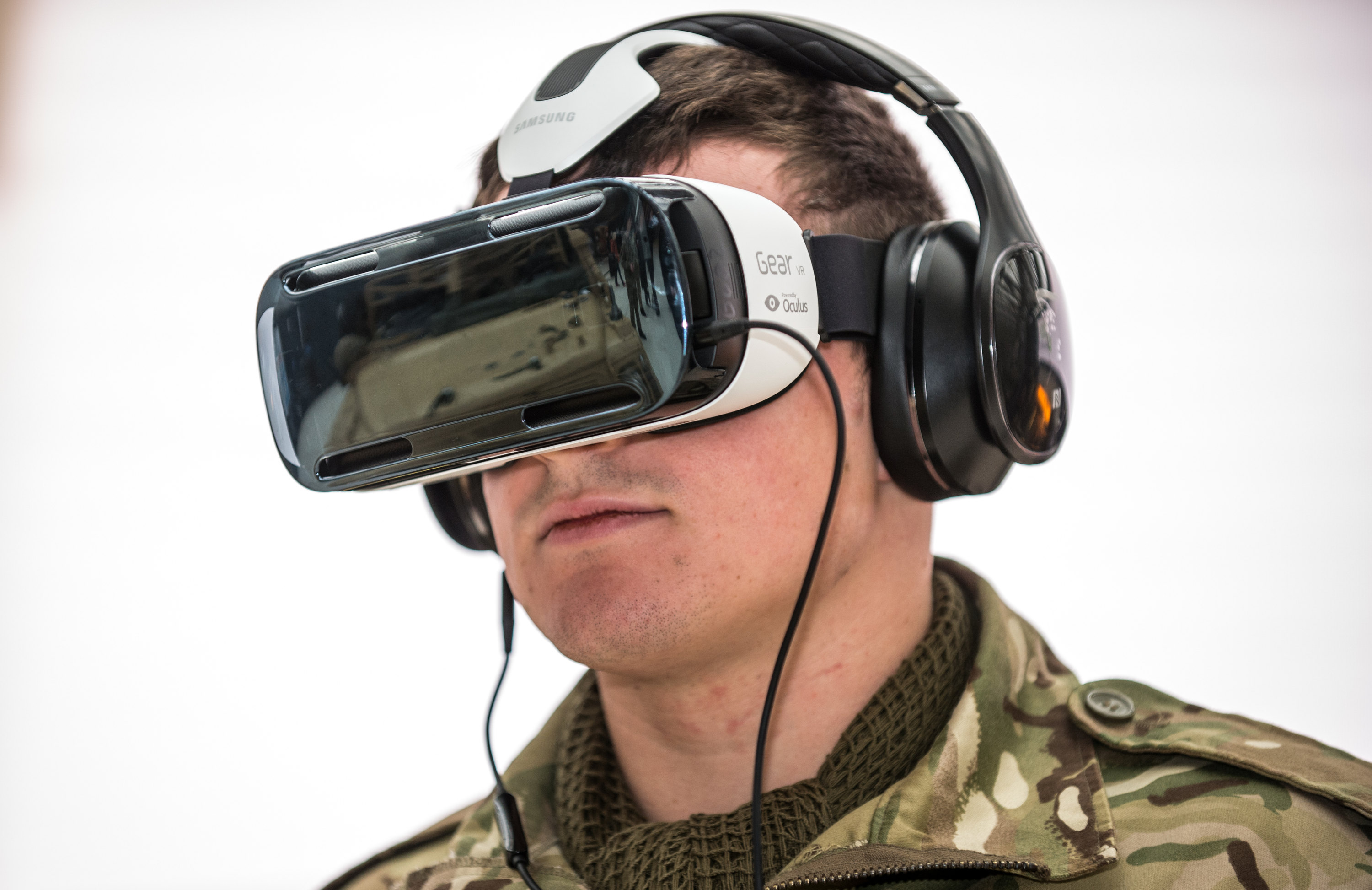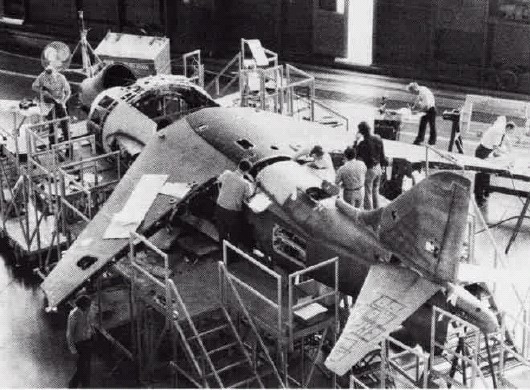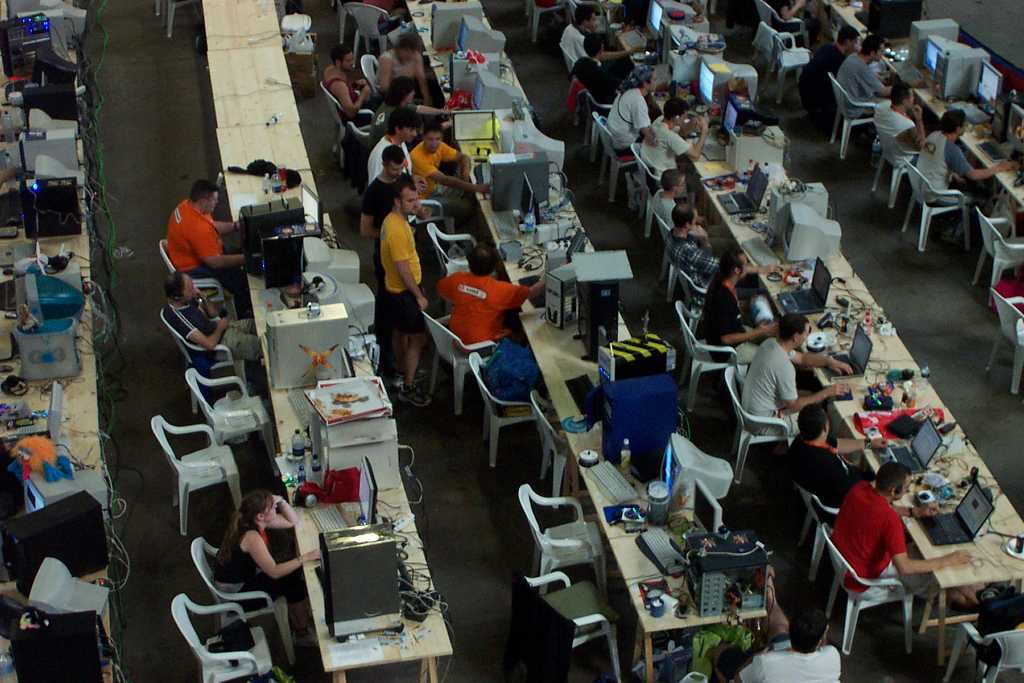|
Deployable Virtual Training Environment (DVTE)
The Deployable Virtual Training Environment (DVTE) is a laptop based platform for a wide variety of training simulations in the USMCTRASYS web. DVTE consists of two main components, the Combined Arms Network (CAN) and the Infantry Tool Kit (ITK). A typical DVTE suite consists of 32 laptops and a modified NVisor SX Head-mounted display (HMD). The current version of the CAN was developed by the ONR VIRTE program as part of its Demo 3 and is based on the JSAF simulation. It uses the Open Source Delta3D toolkit for visualization. Each laptop can be reconfigured to simulate a variety of USMC platforms including the M1 Abrams, Amphibious Assault Vehicle (AAV), LAV-25, AV-8 Harrier II, and the AH-1 Cobra. The Infantry Tool Kit consists of a number of stand-alone games and simulations. The main simulation is a first-person shooter called VBS2. Other applications include: the DARPA developed DARWARS Tactical Iraqi (part of the Tactical Language & Culture Training System Tactic(s) ... [...More Info...] [...Related Items...] OR: [Wikipedia] [Google] [Baidu] |
Head-mounted Display
A head-mounted display (HMD) is a display device, worn on the head or as part of a helmet (see Helmet-mounted display for aviation applications), that has a small display optic in front of one ( monocular HMD) or each eye (binocular HMD). An HMD has many uses including gaming, aviation, engineering, and medicine. Virtual reality headsets are HMDs combined with IMUs. There is also an optical head-mounted display (OHMD), which is a wearable display that can reflect projected images and allows a user to see through it. Overview A typical HMD has one or two small displays, with lenses and semi-transparent mirrors embedded in eyeglasses (also termed data glasses), a visor, or a helmet. The display units are miniaturized and may include cathode ray tubes (CRT), liquid-crystal displays (LCDs), liquid crystal on silicon (LCos), or organic light-emitting diodes (OLED). Some vendors employ multiple micro-displays to increase total resolution and field of view. HMDs differ in ... [...More Info...] [...Related Items...] OR: [Wikipedia] [Google] [Baidu] |
Office Of Naval Research
The Office of Naval Research (ONR) is an organization within the United States Department of the Navy responsible for the science and technology programs of the U.S. Navy and Marine Corps. Established by Congress in 1946, its mission is to plan, foster, and encourage scientific research to maintain future naval power and preserve national security. It carries this out through funding and collaboration with schools, universities, government laboratories, nonprofit organizations, and for-profit organizations, and overseeing the Naval Research Laboratory, the corporate research laboratory for the Navy and Marine Corps. NRL conducts a broad program of scientific research, technology and advanced development. ONR Headquarters is in the Ballston neighborhood of Arlington, Virginia. ONR Global has offices overseas in Santiago, Sao Paulo, London, Prague, Singapore, and Tokyo. Overview ONR was authorized by an Act of Congress, Public Law 588, and subsequently approved by Preside ... [...More Info...] [...Related Items...] OR: [Wikipedia] [Google] [Baidu] |
VIRTE
VIRtual Training and Environments (VIRTE) was an Office of Naval Research Science and Technology program from 2002 to 2007 led by CDR Dylan Schmorrow. It was funded under the Capable Manpower Future Naval Capability (FNC) and produced research in Virtual Environments. The VIRTE program was divided into three related demonstrations. Demo 1 developed virtual simulators for the LCAC LCAC may refer to: Hovercraft * A generic term for an air cushioned landing craft, taken from US Navy designation "Landing Craft, Air Cushion". ** Landing Craft Air Cushion, a US Navy hull classification symbol for the Landing Craft Air Cushion-c ..., the EFV, and a helicopter. Demo 2 concentrated on technologies to support Immersive Infantry Training. Demo 3 developed laptop based simulators for a wide variety of USMC platforms and was fielded as part of the Deployable Virtual Training Environment (DVTE). External links I/ITSEC 2003 Paper Military exercises and wargames United States Navy organ ... [...More Info...] [...Related Items...] OR: [Wikipedia] [Google] [Baidu] |
JSAF
Joint Semi-Automated Forces (JSAF) is a U.S. government owned and developed simulation system. It is widely used in training and experimentation. Current users include the Joint Forces Command, the Navy Warfare Development Command (NWDC), and the USMC DVTE program. JSAF was developed as part of the DARPA The Defense Advanced Research Projects Agency (DARPA) is a research and development agency of the United States Department of Defense responsible for the development of emerging technologies for use by the military. Originally known as the Ad ... Synthetic Theater of War (STOW) Advanced Concept Technology Demonstration (ACTD). External links HPC SpiderNavy Warfare Development Command Military simulation ... [...More Info...] [...Related Items...] OR: [Wikipedia] [Google] [Baidu] |
M1 Abrams
The M1 Abrams is a List of main battle tanks by generation, third-generation American main battle tank designed by Chrysler Defense (now General Dynamics Land Systems) and named for General Creighton Abrams. Conceived for modern Armoured warfare, armored ground warfare and now one of the heaviest tanks in service at nearly 68 short tons (almost 62 tonne, metric tons), it introduced several modern technologies to US armored forces, including a multifuel gas turbine, turbine engine, sophisticated Chobham armour, Chobham composite armor, a computer fire control system, separate ammunition storage in a blow-out compartment, and Weapon of mass destruction, NBC protection for crew safety. Initial models of the M1 were armed with a licensed-produced 105 mm Royal Ordnance L7 gun, while later variants feature a licensed Rheinmetall Rh-120, Rheinmetall 120 mm L/44. The M1 Abrams was developed from the failure of the MBT-70 project to replace the obsolescent M60 tank. There are three ... [...More Info...] [...Related Items...] OR: [Wikipedia] [Google] [Baidu] |
Amphibious Assault Vehicle
The Assault Amphibious Vehicle (AAV)—official designation AAVP-7A1 (formerly known as Landing Vehicle, Tracked, Personnel-7 abbr. LVTP-7)—is a fully tracked amphibious landing vehicle manufactured by U.S. Combat Systems (previously by United Defense, a former division of FMC Corporation). The AAV-P7/A1 is the current amphibious troop transport of the United States Marine Corps. It is used by U.S. Marine Corps Amphibious Assault Battalions to land the surface assault elements of the landing force and their equipment in a single lift from assault shipping during amphibious operations to inland objectives and to conduct mechanized operations and related combat support in subsequent mechanized operations ashore. It is also operated by other forces. Marines call them "amtracs", a shortening of their original designation, "amphibious tractor". In June 2018, the Marine Corps announced they had selected the BAE Systems/Iveco wheeled SuperAV for the Amphibious Combat Vehicle (ACV ... [...More Info...] [...Related Items...] OR: [Wikipedia] [Google] [Baidu] |
LAV-25
The LAV-25 is a member of the LAV II family. It is an eight-wheeled amphibious armored reconnaissance vehicle built by General Dynamics Land Systems and used by the United States Marine Corps and the United States Army. History During the 1980s, the U.S. Marine Corps began looking for a light armored vehicle to give their divisions greater mobility. In April 1981, the DoD opened submissions to the LAV program. Three contractors were downselected. *Alvis – A Scorpion 90 and a three Scorpion APCs. *Cadillac Gage – A V-150S (a stretched V-150) and a V-300. *General Motors of Canada ( General Motors Diesel) – a license-built copy of the Mowag Piranha 8×8 The Marine Corps evaluated the three LAV submissions. In September 1982, the General Motors submission was selected. GM was awarded initial production contract for 969 LAVs. The Army type classified the 25 mm gun variant as the M1047. The Army sought 2,350 of the 12.7 mm (.50) caliber-armed light squad carrier va ... [...More Info...] [...Related Items...] OR: [Wikipedia] [Google] [Baidu] |
AV-8 Harrier II
The McDonnell Douglas (now Boeing) AV-8B Harrier II is a single-engine ground-attack aircraft that constitutes the second generation of the Harrier family, capable of vertical or short takeoff and landing (V/STOL). The aircraft is primarily employed on light attack or multi-role missions, ranging from close air support of ground troops to armed reconnaissance. The AV-8B is used by the United States Marine Corps (USMC), the Spanish Navy, and the Italian Navy. A variant of the AV-8B, the British Aerospace Harrier II, was developed for the British military, while another, the TAV-8B, is a dedicated two-seat trainer. The project that eventually led to the AV-8B's creation started in the early 1970s as a cooperative effort between the United States and United Kingdom, aimed at addressing the operational inadequacies of the first-generation Hawker Siddeley Harrier. Early efforts centered on a larger, more powerful Pegasus engine to dramatically improve the capabilities of th ... [...More Info...] [...Related Items...] OR: [Wikipedia] [Google] [Baidu] |
AH-1 Cobra
The Bell AH-1 Cobra is a single-engined attack helicopter developed and manufactured by the American rotorcraft manufacturer Bell Helicopter. A member of the prolific Huey family, the AH-1 is also referred to as the HueyCobra or Snake. The AH-1 was rapidly developed as an interim gunship in response to the United States Army's needs in the Vietnam War. It used the same engine, transmission and rotor system of the Bell UH-1 Iroquois, which had already proven itself to be a capable platform during the conflict, but paired it with a redesigned narrow fuselage among other features. The original AH-1, being a dedicated attack helicopter, came equipped with stub wings for various weapons, a chin-mounted gun turret, and an armored tandem cockpit, from which its was operated by a pilot and gunner. Its design was shaped to fulfil a need for a dedicated armed escort for transport helicopter, giving the latter greater survivability in contested environments. On 7 September 1965, the ... [...More Info...] [...Related Items...] OR: [Wikipedia] [Google] [Baidu] |
First-person Shooter
First-person shooter (FPS) is a sub-genre of shooter video games centered on gun and other weapon-based combat in a first-person perspective, with the player experiencing the action through the eyes of the protagonist and controlling the player character in a three-dimensional space. The genre shares common traits with other shooter games, and in turn falls under the action game genre. Since the genre's inception, advanced 3D and pseudo-3D graphics have challenged hardware development, and multiplayer gaming has been integral. The first-person shooter genre has been traced back to '' Wolfenstein 3D'' (1992), which has been credited with creating the genre's basic archetype upon which subsequent titles were based. One such title, and the progenitor of the genre's wider mainstream acceptance and popularity, was '' Doom'' (1993), often considered the most influential game in this genre; for some years, the term ''Doom'' clone was used to designate this genre due to ''Doom''s ... [...More Info...] [...Related Items...] OR: [Wikipedia] [Google] [Baidu] |
DARWARS
{{nofootnotes, date=June 2016 DARWARS was a research program at DARPA intended to accelerate the development and deployment of military training systems. These were envisioned as low-cost, mobile, web-centric, simulation-based, “lightweight” systems designed to take advantage of the ubiquitous presence of the PC and of new technology, including multi-player games, virtual worlds, off-the-shelf PC simulations, intelligent agents, and on-line communities. The project started in 2003 under the leadership of DARPA Program Manager Dr. Ralph Chatham, a former U.S. Navy officer. The program is producing an architectural framework, including a set of web services, tools, and system interface definitions that facilitate the development of networked training systems. The scalable framework supports training for individuals, teams, or teams of teams (involving students at PCs interacting on a virtual battlefield). Training systems keep track of student performance in order to offer indiv ... [...More Info...] [...Related Items...] OR: [Wikipedia] [Google] [Baidu] |
Tactical Language & Culture Training System
Tactic(s) or Tactical may refer to: * Tactic (method), a conceptual action implemented as one or more specific tasks ** Military tactics, the disposition and maneuver of units on a particular sea or battlefield ** Chess tactics ** Political tactics * TACTIC (military program), a U.S. military research program conducted by DARPA Computer science * TACTIC (web framework), a smart process application by Southpaw Technology Geography * Tactic, Guatemala, a municipality in the Alta Verapaz department Entertainment * Tactics, a dart game similar to cricket * "Tactics", a 1995 song by The Yellow Monkey * ''Tactics'' (album), a 1996 album by John Abercrombie * Tactics (band), an Australian band * ''Tactics'' (game), generally credited as the first board wargame * ''Tactics'' (manga), a Japanese manga series * ''Tactic'' (video game), a puzzle video game * Tactics (video games studio) is a Japanese software publishing company specializing in the publishing and distribution of ... [...More Info...] [...Related Items...] OR: [Wikipedia] [Google] [Baidu] |



.jpg)



